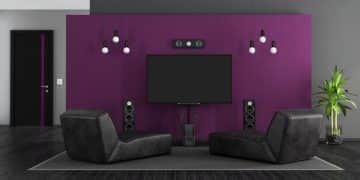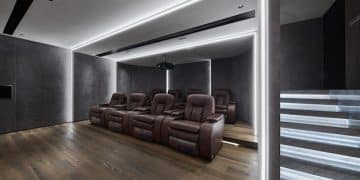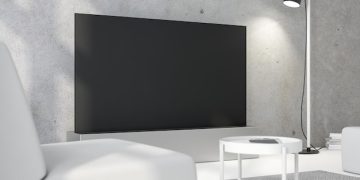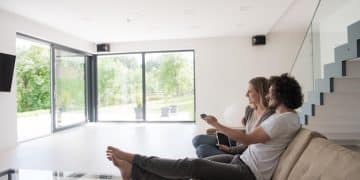DIY Smart Home Theater: Automate Your Entertainment Under $500
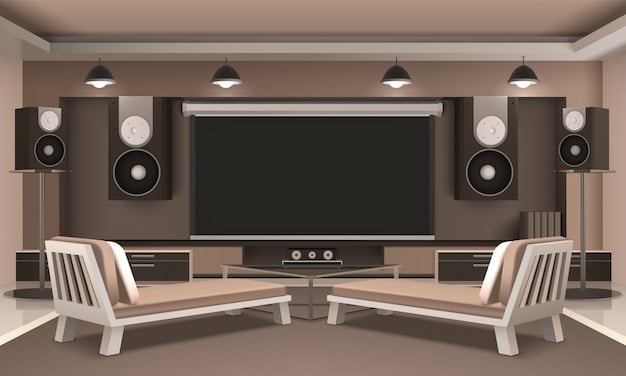
Creating a DIY smart home theater involves automating lighting, sound, and projection systems for an immersive experience, achievable for under $500 through strategic component selection and smart home integrations.
Transforming your living room into a personal cinematic oasis doesn’t have to break the bank. A DIY smart home theater: automate lighting, sound, and projection for under $500 is within reach by leveraging affordable technology and a bit of ingenuity.
Getting Started: Planning Your Budget Smart Home Theater
Embarking on a DIY smart home theater project requires careful planning, especially when working with a limited budget. Setting clear goals and understanding your current setup are vital first steps.
Before diving into component selection, assess your room’s physical characteristics and define what “smart” functionalities matter most to you. This will guide your purchasing decisions and prevent overspending.
Assessing Your Existing Setup
Begin by evaluating the components you already own. Do you have a projector, speakers, or a receiver that can be integrated into your smart home setup? Identifying reusable items allows you to allocate your budget more efficiently.
Consider the connectivity options of your current devices. Are they compatible with smart hubs or voice assistants like Amazon Alexa or Google Assistant? Understanding these factors will ease the integration process.
- Identify existing components that can be reused.
- Assess the connectivity of current devices.
- Determine compatibility with smart hubs or voice assistants.
Once you’ve evaluated your starting point, create a comprehensive wish list. Prioritize features that enhance your viewing experience, such as automated lighting, synchronized sound, and easy projector control.
Choosing the Right Projector and Screen on a Budget
Selecting an affordable yet capable projector and screen is a crucial aspect of your DIY smart home theater. While high-end projectors can be costly, several budget-friendly options deliver impressive performance.
Consider factors like resolution, brightness, and contrast ratio when evaluating projectors. Opting for a native resolution of 1080p ensures a sharp and clear image, while brightness levels suitable for a dimly lit room will suffice.
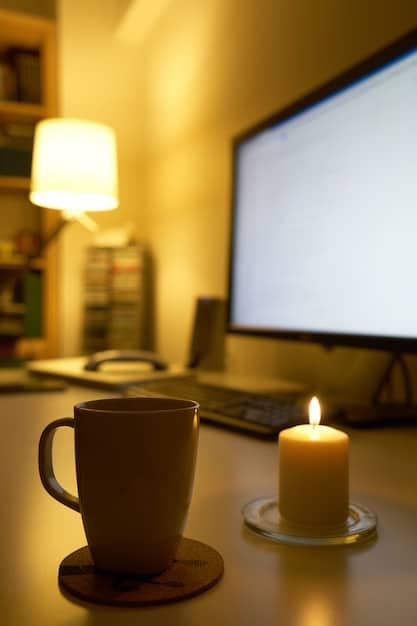
When it comes to screens, a simple white wall can work in a pinch, but investing in a dedicated projector screen enhances image quality. Look for screens with high gain to maximize brightness and contrast.
Exploring both fixed-frame and retractable screen options allows you to choose a solution that best suits your space and aesthetic preferences. DIY screen solutions, such as using blackout cloth, are even more economical.
- Evaluate projectors based on resolution, brightness, and contrast ratio.
- Consider the benefits of using a dedicated projector screen.
- Explore DIY screen solutions for added cost savings.
Many users have found success with refurbished projectors. These units often provide excellent value, offering near-new performance at a fraction of the cost. Always check the warranty and return policies before purchasing.
Smart Lighting Automation for Immersive Viewing
Automated lighting is a key component of a smart home theater, enabling you to create the perfect ambiance for movie nights. Smart bulbs and lighting control systems can transform your viewing experience.
Integrating smart bulbs into your existing lighting fixtures allows you to adjust brightness, color temperature, and even create custom lighting scenes. Dimming the lights automatically when a movie starts increases immersion.
Smart lighting hubs and voice assistants can streamline control. Using voice commands like “Alexa, dim the lights” or “Hey Google, theater mode” enhances convenience and user experience.
Setting Up Smart Lighting
Start by replacing your existing bulbs with smart bulbs compatible with your chosen smart home ecosystem. Many affordable options are available, supporting various color temperatures and brightness levels.
Configure lighting scenes within your smart home app. Create a “movie night” scene that dims the lights to a comfortable level, enhancing the viewing experience without being distracting.
Consider adding smart light strips behind your TV or projector screen to minimize eye strain and add a stylish backlight effect.
Connecting your smart lighting to your projector or streaming device can automate even more. For example, the lights dim automatically when you start playing a movie.
Investing in a smart remote control can act as a central hub, allowing you to control lighting, audio, and projection simultaneously. This simplifies the user experience and adds convenience.
Enhancing Audio with Smart Sound Systems
Audio quality is just as important as visual fidelity in creating a home theater experience. Integrating smart speakers and audio automation enhances sound immersion and control.
Affordable smart speakers can be easily integrated into your existing audio setup. From soundbars to surround sound systems, numerous budget-friendly options enhance your auditory experience.
Voice-controlled audio systems allow you to adjust volume, switch inputs, and control playback hands-free. Integrate your smart speakers with voice assistants like Amazon Alexa or Google Assistant, enabling convenient control.
- Explore affordable smart speakers for enhanced audio quality.
- Integrate voice control for hands-free audio adjustments.
- Consider soundbars for a streamlined audio setup.
Setting up a multi-room audio system enables you to expand your sound experience beyond the home theater, creating synchronized audio throughout your home.
Controlling Your Devices with Smart Home Hubs
A smart home hub is the central control point for all your connected devices. These hubs allow you to automate and manage lighting, sound, and projection seamlessly.
Popular smart home hubs like the Amazon Echo Plus or Google Home offer native support for numerous devices. These hubs simplify the integration process and provide user-friendly interfaces.
Setting up scenes and routines within your smart home hub allows you to automate sequences of actions. For example, initiating a “movie night” scene can dim the lights, lower the projector screen, and adjust the audio settings simultaneously.
Choosing the Right Smart Home Hub
Consider compatibility with your existing devices when choosing a smart home hub. Ensure that the hub supports the protocols and standards used by your smart bulbs, speakers, and projectors.
Evaluate the range and reliability of the wireless connectivity offered by the hub. A strong and stable connection is crucial for seamless operation.
Many smart home hubs support IFTTT (If This Then That) integration, enabling you to create custom automations based on specific triggers and actions.
Investing in a universal remote control adds another layer of control and convenience. Program all your devices into one remote, simplifying the user interface.
Troubleshooting Common DIY Smart Home Theater Issues
While setting up a DIY smart home theater can be rewarding, common issues may arise during the integration process. Troubleshooting these challenges efficiently ensures a smooth and enjoyable experience.
Connectivity problems are a frequent concern. Ensure that all your devices are properly connected to your Wi-Fi network and that your smart home hub is within range.
Compatibility issues can also cause problems. Double-check that your devices are compatible with your smart home hub and that you have installed the latest firmware updates.
- Address connectivity issues by ensuring Wi-Fi stability.
- Verify device compatibility with your smart home hub.
- Update firmware to resolve potential bugs and glitches.
If you encounter performance issues, such as lag or slow response times, consider optimizing your Wi-Fi network. Reducing interference and improving signal strength can enhance performance.
Consult online forums and communities for troubleshooting tips. Many DIY enthusiasts share their experiences and offer solutions to common problems.
| Key Point | Brief Description |
|---|---|
| 💡 Budget Planning | Assess current setup & prioritize smart features. |
| 🎬 Projector & Screen | Choose 1080p projector & consider DIY screen options. |
| 🔊 Smart Sound | Integrate voice-controlled audio system for immersion. |
| 🤖 Smart Home Hub | Automate devices with routines & IFTTT integrations. |
FAQ
▼
Yes, it is achievable with careful planning, affordable components, and a few DIY solutions. Prioritize essential features and reuse existing equipment.
▼
The projector and screen are crucial for visual quality, while smart lighting and audio significantly enhance the immersive experience, controlled by a reliable smart home hub.
▼
Consider using blackout cloth as a DIY screen solution. This material is inexpensive and provides a flat, reflective surface for optimal image quality.
▼
The Amazon Echo Plus or Google Home are both affordable and offer broad compatibility with various smart devices, making them suitable for a budget-conscious setup.
▼
Ensure all devices are properly connected, check Wi-Fi stability, and verify device compatibility with your smart home hub. Update firmware to resolve potential bugs.
Conclusion
Building a DIY smart home theater: automate lighting, sound, and projection for under $500 turns your home into an entertainment hub without overspending. By strategically selecting budget-friendly components, automating lighting and sound, and using a central smart home hub, you can create an immersive and convenient viewing experience.
